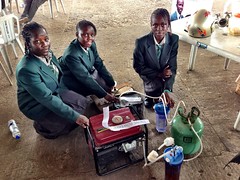| This image of an African man with rubber man around his head has gone viral with a new country named in each e-mail in order to ridicule the nationals of that country although it probably originated in South Africa as signified by the references on the computer screen.. Photo credit:unknown |
The latest series of such type of photos were included on a blog run by the Africa Geographic Safari magazine which also has some of these images on its Facebook page. It credits the source of the photos to another Facebook page, Africa, This is why I live here – owned by AfricaThisiswhyI livehere.com- a wildlife blog that promotes conservation of Rhinos. There is a note on the ‘about’ section of the Facebook site of the latter, reading “not intended for anyone with a bad sense of humor”. On the Africa Geographic magazine, the user comments also make reference to the humor in the photos and the ‘ingenuity’ of African peoples. Whilst no malice is intended by displaying these images, the messages conveyed cannot be viewed simply in jest because of the context that they are presented and their messages.
Pictures Worth a Thousand Inventions
In light of the blog’s content, the title “11 amazing devices that could only have been invented in Africa” is problematic. It introduces an element of ‘otherness’ to African people and products coming out of Africa. It writes that this type of ‘inventiveness’ can only occur in one geographic location, Africa, and not another. This suggests that Africa invents one type of invention (makeshift ones) and not any other (true inventions). It implies that real inventions occur outside of the African continent and not within it. Furthermore, it implies that nothing new really comes out of the continent; instead, innovation takes the form of crude adaptations –that make use of anything in reach-to things already invented elsewhere.
They give the impression that Africans simply mimic things without a deeper understanding of how they function or in what context they function in. The stereotypical associations that these images conjure have real life consequences for many Africans in classrooms and in work places that are prejudged as bringing no real innovation.
Equally problematic for Africans are that the ‘African inventions’ photos are presented by wildlife and safari themed sites in the middle of content primarily about wildlife. This poses problems because since they primarily focus on Africa’s environment, and seldom people, the way they present people makes a more pronounced statement. When a magazine about flora and fauna frequently depicts people in a similar manner, it creates lasting impressions in the mind of the viewers of the images of those people. It contrasts clever animals adapting to nature in their natural habitat to slow humans trying to adapt technology. Readers of the site are bombarded with numerous photos of animals doing a variety of tasks, whilst the few African people being shown are doing ‘silly’ things like tying numerous tires around a car for ‘safety’ purposes.
There are other nuances surrounding the relationship between Africa’s wildlife and African people that manifest given that these images appear in the context of ‘environmentally’ – themed platforms. African people are usually not depicted as part of Africa in much of the popular imagination of wildlife enthusiasts -Tourists go on Safari to look at animals and conservationists are looking to save them! When people are rarely featured in the backdrop of African nature for tourism purposes, they are usually adding to the ‘exoticism’ of the environment. The dynamics of the Global North and Global South also play out here because typically tourists shown are from the Global North or ‘outlander’ types who are ‘roughing’ it in 'wild Africa'. When depicted in conservation magazines, people are destroying the environment with their ‘modern ways’. Conservationists from the Global North are depicted saving the environment where local people are usually destroying it. Therefore, the fact that these images appear in the backdrop of many stereotypes and grand narratives surrounding the romanticism of African wildlife, how African people are depicted becomes more conspicuous. So, rather than inventions portraying ‘ingenuity’ ‘humor’ and ‘cuteness’ in the continent; the photos begin to come across as patronizing and projecting the idea that when it comes to inventions, Africans are a little dull.
Africa's Real Inventions
| A urine powered generator was invented by Nigerian teenagers, Duro-Aina Adebola (14), Akindele Abiola (14), Faleke Oluwatoyin (14) and Bello Eniola (15) in 2012. These types of real and useful inventions though are less likely to go viral on social media. (Photo credit: whiteafrican) |
Whilst all these nature site platforms are enthusiastic about the continent, its peoples, and its wildlife, the messages they are sending out about African people through these series of photos needs better reflection. To the credit of Safari magazine, they do have a blog post about the Mozambican Fashion Show that does show African people in positive light in terms of invention. There is also another post that shows Santa sightings throughout Africa that is humorous without bordering on offensive. However, it is important to note that the final video on that page from a charity called Ripple Africa in Malawi is problematic and needs an analysis on its own. The majority of the site does not have images of Africa’s real ingenuity and inventiveness to provide for a more balanced representation. There are many inventions that came out of the continent that need greater awareness so that they can balance out such types of 'non-inventions' that often circulate around the internet. In a world where both Africans and non-Africans believe no inventions came from Africa, the popular image of Africa's ingenuity should not be limited to make-shift non-inventions on the internet for amusement. It should also incorporate the real inventions coming out of the continent that should drive Africa's future.
This article also appeared on 'Africa on the Blog' on 12/21/2012

